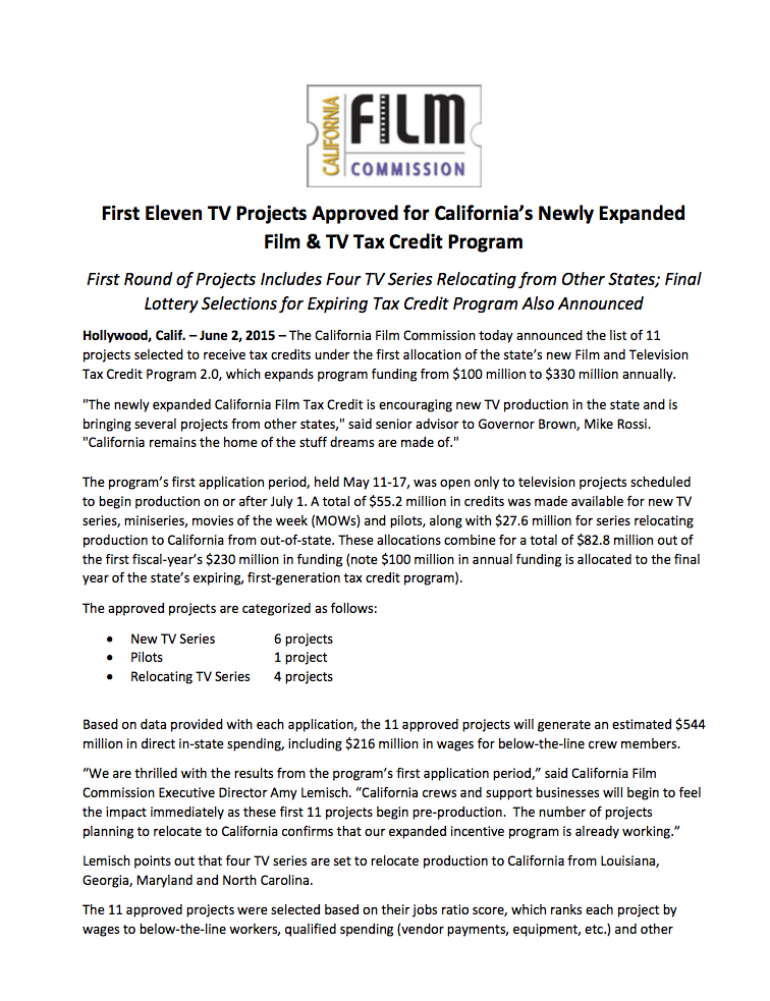First Eleven TV Projects Approved for California’s Newly Expanded Film & TV Tax Credit Program
Download Press ReleaseFirst Round of Projects Includes Four TV Series Relocating from Other States; Final Lottery Selections for Expiring Tax Credit Program Also Announced
Hollywood, Calif. – June 2, 2015 – The California Film Commission today announced the list of 11 projects selected to receive tax credits under the first allocation of the state’s new Film and Television Tax Credit Program 2.0, which expands program funding from $100 million to $330 million annually. "The newly expanded California Film Tax Credit is encouraging new TV production in the state and is bringing several projects from other states," said senior advisor to Governor Brown, Mike Rossi. "California remains the home of the stuff dreams are made of."
The program’s first application period, held May 11-17, was open only to television projects scheduled to begin production on or after July 1. A total of $55.2 million in credits was made available for new TV series, miniseries, movies of the week (MOWs) and pilots, along with $27.6 million for series relocating production to California from out-of-state. These allocations combine for a total of $82.8 million out of the first fiscal-year’s $230 million in funding (note $100 million in annual funding is allocated to the final year of the state’s expiring, first-generation tax credit program).
The approved projects are categorized as follows:
- New TV Series -- 6 projects
- Pilots -- 1 project
- Relocating TV Series -- 4 projects
Based on data provided with each application, the 11 approved projects will generate an estimated $544 million in direct in-state spending, including $216 million in wages for below-the-line crew members. “We are thrilled with the results from the program’s first application period,” said California Film Commission Executive Director Amy Lemisch. “California crews and support businesses will begin to feel the impact immediately as these first 11 projects begin pre-production. The number of projects planning to relocate to California confirms that our expanded incentive program is already working.”
Lemisch points out that four TV series are set to relocate production to California from Louisiana, Georgia, Maryland and North Carolina. The 11 approved projects were selected based on their jobs ratio score, which ranks each project by wages to below-the-line workers, qualified spending (vendor payments, equipment, etc.) and other criteria. This new jobs ratio protocol for selecting projects replaces the prior lottery system employed by the state’s first-generation tax credit program.
The 11 approved projects were among the 37 TV projects that applied during the new program’s first application period. The remaining projects with a jobs ratio score ranked in the top 200 percent of applicants have been placed on a waiting list.
Another change under the newly-expanded program is eligibility to a wider range of TV project types, including new series for network, premium cable outlets, and internet distribution, as well as pilots. The new program also allocates tax credits in “buckets” for different production categories, including TV projects, relocating TV series, independent projects and non-independent films. This enables applicants to compete for credits directly against comparable projects.
Wrapping-Up the State’s Expiring Tax Credit Program
In addition to announcing the first round of projects selected for the newly-expanded program, the California Film Commission also announced the list of projects approved conditionally for the final round of state’s first-generation tax credit program, which held its final abbreviated lottery on April 1.
The abbreviated lottery was open only to independent projects due to the program’s success in attracting and retaining television series. A total of 16 films were selected to receive credits reserved specifically for independent projects. The rest of the old program’s final $100 annual allocation will go to the 11 returning TV series accepted for an automatic allocation renewal.
A total of 246 applications were received prior to the lottery held on April 1. Those not among the 16 selected provisionally to receive credits have been placed on the waiting list. As with past lotteries, the Film Commission expects many wait list projects to ultimately receive tax credits, as some approved projects withdraw due to scheduling delays and/or other production-related factors. When a project withdraws, its credits are reassigned to the project(s) next in line on the waiting list.
Under both the old and new programs, the California Film Commission awards tax credits only after each selected project: 1) completes post-production, 2) verifies that in-state jobs were created, and 3) provides all required documentation, including audited cost reports.
The next application period for the new tax credit program is scheduled for July 13-25, with a funding bucket of $48.3 million for feature films and $6.9 million for independent projects.
More information about California’s newly-expanded Film and Television Tax Credit Program 2.0, including application procedures, eligibility and program guidelines, is available at http://film.ca.gov/incentives.
About California’s Film and Television Tax Credit Program 2.0
On September 18, 2014, Governor Brown signed bipartisan legislation to more than triple the size of California’s film and television production incentive, from $100 million to $330 million annually. Aimed at retaining and attracting production jobs and economic activity across the state, the California Film and TV Tax Credit Program 2.0 also extends eligibility to include a range of project types (big-budget feature films, TV pilots and 1-hr TV series for any distribution outlet) that were excluded from the state’s first-generation tax credit program. Other key changes include replacing the prior lottery system with a “jobs ratio” ranking system that selects projects based on wages paid to below-the-line workers, qualified spending (vendor payments, equipment, etc.) and other criteria. In addition, “uplifts” are now available for projects that shoot outside the Los Angeles 30-mile zone or have qualified expenditures for visual effects or music scoring/track recording.
About the California Film Commission
The California Film Commission enhances California's status as the leader in motion picture, television and commercial production. It supports productions of all sizes and budgets, and focuses on activities that stimulate and preserve production spending, jobs and tax revenues in California. Services include administration of the state's Film & Television Tax Credit Program, permits for filming at state-owned facilities, an extensive digital location library, location assistance and a range of other production- related resources and assistance. More information is available at http://www.film.ca.gov.
Contact: Erik Deutsch, ExcelPR Group (for the California Film Commission) (323) 851-2455 direct / (310) 597-9245 cell / erikd@excelpr.com










